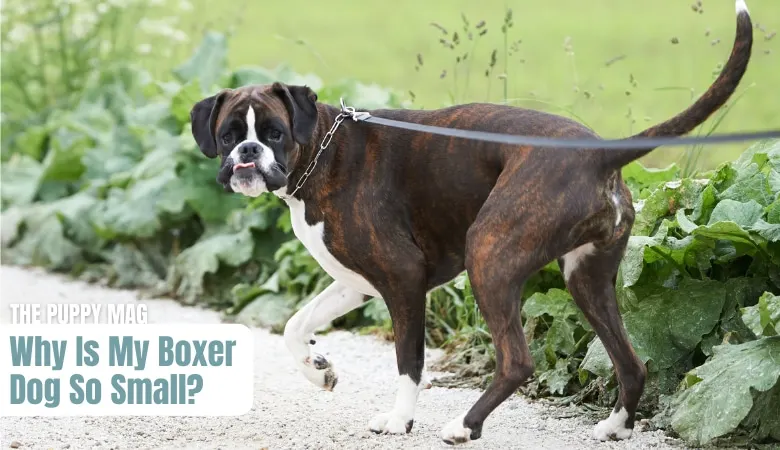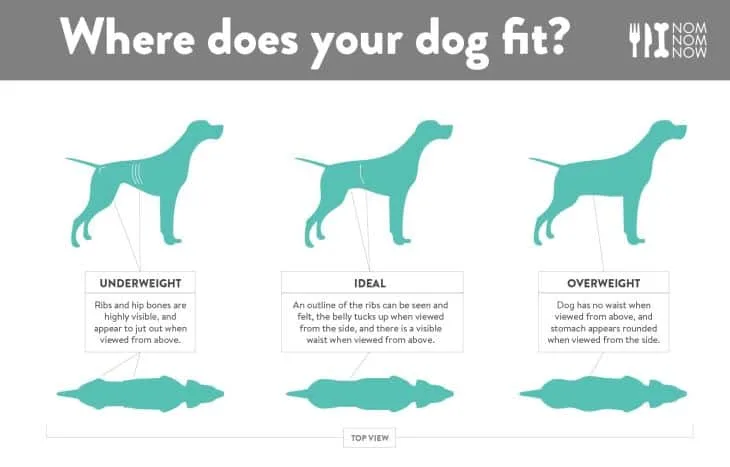Boxers are supposed to be large dogs, right? If you’re looking at your boxer and wondering why he looks so small, you aren’t alone. This is a common question many boxer owners have.
This article will explain the correct size of a boxer, why yours may be small, and what you can do about it.

What’s The Correct Size For a Boxer Dog?
In order for us to really know if your boxer is on the small side, it’s necessary to look at the breed averages.
The AKC has given the following height and weight ranges for both male and female adult boxers:
Male Boxers ⭐
● Height: 23-25 inches
● Weight: 65-80 pounds
From my experience, I have rarely come across a male that weighs as much as 80 pounds. Most males I have seen weigh on average 70 pounds.
Female Boxers ⭐
● Height: 21.5-23.5 inches
● Weight: 50-65 pounds
“about 15 pounds less than males”
It’s important to note that these are the breed standard averages, and are for adults, not for puppies.
So after seeing those figures, how does your boxer compare? You may be surprised to know he’s actually within the normal range for a boxer.
When Do Boxers Stop Growing? Boxer Puppy Growth Chart
For those who still have puppies, it’s a good idea to become familiar with their typical growth timeline. This way you’ll know how big he should be for his age.
| Age In Months | Male: Inches & Pounds | Female: Inches & Pounds |
|---|---|---|
| 4-6 Months | Height: 12-14 Weight: 30-45 | Height: 12-14 Weight: 20-35 |
| 6-8 Months | Height: 14-18 Weight: 45-55 | Height: 14-16 Weight: 35-45 |
| 8-10 Months | Height: 18-22 Weight: 55-60 | Height: 16-18 Weight: 45-55 |
| 10-12 Months | Height: 22-24 Weight: 60-65 | Height: 18-20 Weight: 55-60 |
| 12-14 Months | Height: 22-25 Weight: 65-70 | Height: 20-22 Weight: 55-65 |
| 14-16 Months | Height: 22-25 Weight: 65-80 | Height: 20-23 Weight: 55-65 |
You’ll notice that the ranges increase at a quicker rate between 4 and 10 months. This is because puppies grow the most during this stage and start to slow down around the 10-12 month point.
You will also notice that in most cases, full height will be reached by 10-12 months.
However, keep in mind that full weight can keep slowly increasing up to 16 months, and in many cases, even beyond.
Reasons Why Your Boxer Is Small
If after comparing your boxer’s height and weight to the ranges above you realize he is in fact smaller than average, the following reasons should shed some light on the situation.
Four main reasons why your boxer is small:
- Genes & Breed Variation
- Diet and Eating Habits
- Exercise Issues
- Health Concerns
1. Genes & Breed Variation
The first point to acknowledge is your boxer’s genetic make-up and his breed variation.
There are three different variations of the boxer. The UK boxer, the German boxer, and the American boxer. Although there are not many differences between them, the German boxer does have a bigger bone structure and grows to be slightly taller and heavier than a UK boxer or American boxer.
This is important to know because maybe you’ve been comparing your UK or American boxer to a German boxer without realizing (they look pretty similar). This would without a doubt give you the impression that your boxer is smaller than average, when he may not be.
Genes also come into it. If the parents of your boxer were both on the smaller side, then it’s likely your boxer will be small too. And vice versa.
Plus there is also the chance of mixed breeding between each different boxer variation. Maybe you have a German boxer, but in his lineage has UK or American boxer DNA, thus, bringing his physical size down a notch.
What You Can Do
As you may have guessed, there’s not much you can do regarding genes or breed variation.
And more than likely, you are not familiar with your boxer’s parents. If you have contact with your breeder it may be worth confirming details about the parents. But if you rescued your boxer from a shelter, it’s going to be very hard to find out any information.
2. Diet and Eating Habits
Your boxer’s diet and eating habits are essential for his overall growth and development, particularly during puppyhood when he’s doing most of his growing.
Boxers are an athletic and energetic breed that needs their fair share of calories. Without a sufficient daily diet, calories in general, or the wrong nutrient breakdown, your boxer may not be able to grow, develop, and recover as he should.
And this can happen from bad eating habits too. He may have the correct diet, but that’s no good if he refuses it.
This is important throughout his adult years, but as you can imagine, it’s even more crucial when he’s a puppy and needs to grow and develop into his full adult size. This is when he most needs all the nutrients he can get.
What You Can Do
When it comes to diet, it’s important to make changes slowly. This avoids upsetting his stomach and allows you to accurately evaluate how the changes are impacting him.
If you make too many adjustments in a short space of time, you won’t know what’s adding benefit, and what’s taking away from his progress.
● Use a premium brand. Using a high-quality kibble is standard nowadays, and it’s not recommended to settle for anything less. Sticking to a trusted, well-known brand will give you a better chance of properly fulfilling his nutritional needs. The quality of the ingredients as well as the breakdown between protein, fat, and carbs, all play a role in his ability to grow, develop, and recover.
● Avoid “all-round” generic kibbles. I mean two things with this. If your boxer is a puppy, make sure you are using a kibble that’s formulated for large breed puppies, like the boxer is. This also goes for if your boxer is an adult, avoid “all-life stages” and get him a large breed adult formula. This is because dietary requirements change depending on your boxers age, especially when he’s a puppy. Large breed puppy-specific formulas contain the appropriate nutrients that a large breed puppy needs.
● Follow an 80% dry kibble, 20% wet dog food split. This is often recommended by veterinarians and is perhaps the best way to combat fussy eaters and food refusals. Wet kibble is extremely rich in protein, flavor, fewer additives, and preservatives and is far more palatable. Mixing this in occasionally with his mealtimes will make his dinners irresistible.
● Ensure his food works well for him. Boxers can have sensitive stomachs, so it’s really important to try different foods (slowly) until you find one that really works well for him. Even high-quality kibbles may not sit right with every dog out there and if your boxer doesn’t digest it very well, the nutrients likely aren’t entering into his system anyway.
3. Exercise Issues
Boxers are a highly energetic breed and require a lot of daily exercise. Around 1-2 hours per day is appropriate.
But this is for when they are adults.
If your Boxer is under 1.5 years of age, he should not be receiving as much exercise as this. And if he is, it could be hindering his growth.
Up until around 1 and a half years old, your boxer’s bones, joints, and muscles will still be developing and gaining strength. Until this moment, too much stress from exercise may not only cause an injury but hinder his overall growth.
This is actually why puppies sleep so much. Resting is when the vast majority of their growth and development happens so it’s crucial that puppies receive their rest and don’t over-exercise.
It’s the same for us… hitting the gym to set a new personal best on the bench press at age 5 will likely impact natural growth.
What You Can Do
Stick to the 5-minute method for exercising puppies. This requires you to give your puppy dedicated exercise for only 5 minutes per day, per month of age he has. This means at 2 months old, he should receive 10 minutes per day. 3 months = 15 minutes per day, and so on. This can carry on until you are at a max of 1 hour.
Dedicated exercise means putting the leash and harness on and actually going for a walk, even if it’s in your back yard.
This excludes playtime, which again needs to be monitored throughout the day.
4. Health Concerns
In more unfortunate cases, his size could be impacted by an underlying health concern. This may be something he has right now, or it may have only affected him throughout puppyhood.
Many health conditions can affect bone density, muscle mass, overall strength and can cause him to be frail. Illnesses that cause these kinds of symptoms typically happen in old age. But as always, if you are unsure, speak to your veterinarian.
Why Is My Boxer Skinny?
If your boxer is skinny, this is likely due to his diet, eating habits, or a health problem.
Let’s again refer to the average weight sizes for an adult boxer:
● Male adult boxer: 65-80 pounds
● Female adult boxer: 50-65 pounds
The following image should be able to help you distinguish where your boxer is.

Reasons why your boxer may be skinny
● Insufficient diet (calories)
● His body isn’t agreeing with the diet (not successfully digesting it)
● Receiving too much exercise
● Due to a health problem
If you think his diet and eating habits are completely normal and are working well, but he’s still underweight, then it’s important to schedule an appointment with your veterinarian for further health check-ups.
Popular Boxer Articles:
Can Boxers Live Outside?
Why Your Boxer Licks So Much
Why Your Boxer Is Panting So Much
Is Your Boxer Happy and Healthy?
The size of your boxer isn’t everything. Maybe he is on the smaller side, but as long as he’s happy and in full health, it shouldn’t really matter too much.
Remember that males and even females can still gain overall mass until they are around 2 years old. So perhaps your boxer still has some filling out to do if he’s under this age.
Remember that genes and breed variation will also play quite a significant role in how your big your boxer will end up being. Not only does it depend on the size of his parents, but there could be some mixed genes within his bloodline.
Back to more Boxer articles >>
Most Recommended For Boxers
Best Brush For Shedding
Even boxers shed, and to keep those hairs off your floors and clothes, you’ll need a high-quality Slicker Brush. This brush is one of the best for short-haired single-coated breeds like the boxer.
Best Online Training Program
Brain Training For Dogs has become increasingly popular with working dogs in the last few years and is now recognized as one of the best ways to train dogs in the most stress-free, positive way.
Best Low-Calorie Treats
Keep your boxer lean and agile by switching out the high-calorie treats and opting for something healthier. Zuke’s Mini Naturals contain only 2 calories per treat and are made from natural ingredients, making these some of the healthiest treats on the market.
